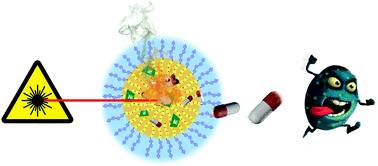Biocompatible nanoparticles containing hydrophobic nickel-bis(dithiolene) complexes for NIR-mediated doxorubicin release and photothermal therapy†
Abstract
Biocompatible nanoparticles (NPs) constituted by amphiphilic poly(ethylene glycol)-block-poly(benzyl malate), PEG-b-PMLABe, have been designed for site-specific PhotoThermal Controlled Release (PTCR) of drugs thanks to the presence of a near infra-red (NIR) photothermally active nickel-bis(dithiolene) complex in the inner core of the NPs, together with doxorubicin (Dox). A nanoprecipitation technique was used to prepare well-defined nickel-bis(dithiolene) and nickel-bis(dithiolene)/Dox loaded NPs, which were characterized by dynamic light scattering (DLS), zeta-potential measurements and Transmission Electron Microscopy (TEM). We have shown that the Dox release was effectively controlled by NIR irradiation (long or pulsed NIR laser irradiation). Cytotoxicity experiments on HeLa and MDA-MB-231 cells have shown that the incorporation of more than 10 w% of nickel-bis(dithiolene) complexes does not increase the intrinsic toxicity of the polymer nanoparticles. Finally, the viability of MDA-MB-231 cells was assessed after their incubation, for 24 hours, with empty NPs, Ni4C12 loaded NPs, Dox loaded NPs or Ni4C12/Dox loaded NPs, without or with NIR irradiation. Above all, the results have highlighted that the Ni4C12 loaded NPs after 5 min NIR laser irradiation can induce strong cell death up to 80% at 50 μg mL−1. These results demonstrate that these NPs are good candidates for photothermal therapy.



 Please wait while we load your content...
Please wait while we load your content...